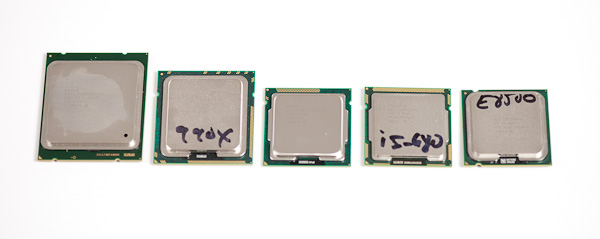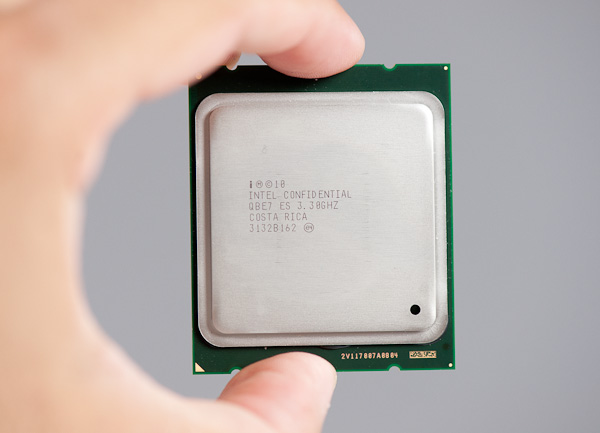Intel Core i7 3960X (Sandy Bridge E) Review: Keeping the High End Alive
by Anand Lal Shimpi on November 14, 2011 3:01 AM EST- Posted in
- CPUs
- Intel
- Core i7
- Sandy Bridge
- Sandy Bridge E
Final Words
There are two aspects of today's launch that bother me: the lack of Quick Sync and the chipset. The former is easy to understand. Sandy Bridge E is supposed to be a no-compromise, ultra high-end desktop solution. The lack of an on-die GPU with Quick Sync support means you have to inherently compromise in adopting the platform. I'm not sure what sort of a solution Intel could've come to (I wouldn't want to give up a pair of cores for a GPU+QuickSync) but I don't like performance/functionality tradeoffs with this class of product. Secondly, while I'm not a SAS user, I would've at least appreciated some more 6Gbps SATA ports on the chipset. Native USB 3.0 support would've been nice as well. Instead what we got was effectively a 6-series chipset with a new name. As Intel's flagship chipset, the X79 falls short.

From left to right: Intel Core i7 (SNB-E), Core i7 (Gulftown), Core i5 (SNB), Core i5 (Clarkdale), Core 2 Duo
LGA-2011, 1366, 1155, 1156, 775
The vast majority of desktop users, even enthusiast-class users, will likely have no need for Sandy Bridge E. The Core i7 3960X may be the world's fastest desktop CPU, but it really requires a heavily threaded workload to prove it. What the 3960X doesn't do is make your gaming experience any better or speed up the majority of desktop applications. The 3960X won't be any slower than the fastest Sandy Bridge CPUs, but it won't be tremendously faster either. The desktop market is clearly well served by Intel's LGA-1155 platform (and its lineage); LGA-2011 is simply a platform for users who need a true powerhouse.
There are no surprises there, we came to the same conclusion when we reviewed Intel's first 6-core CPU last year. If you do happen to have a heavily threaded workload that needs the absolute best performance, the Core i7 3960X can deliver. In our most thread heavy tests the 3960X had no problems outpacing the Core i7 2600K by over 50%. If your livelihood depends on it, the 3960X is worth its entry fee. I suspect for those same workloads, the 3930K will be a good balance of price/performance despite having a smaller L3 cache. I'm not terribly interested in next year's Core i7 3820. Its point is obviously for those users who need the memory bandwidth or PCIe lanes of SNB-E, but don't need more than four cores. I would've liked to have seen a value 6-core offering instead, but I guess with a 435mm2 die size it's a tough sell for Intel management.
Of course compute isn't the only advantage of the Sandy Bridge E platform. With eight DIMM slots on most high end LGA-2011 motherboards you'll be able to throw tons of memory at your system if you need it without having to shop for workstation motherboards with fewer frills.
As for the future of the platform, Intel has already begun talking about Ivy Bridge E. If it follows the pattern set for Ivy Bridge on LGA-1155, IVB-E should be a drop in replacement for LGA-2011 motherboards. The biggest issue there is timing. Ivy will arrive for the mainstream LGA-1155 platforms around the middle of 2012. At earliest, I don't know that we'd see it for LGA-2011 until the end of next year, or perhaps even early 2013 given the late launch of SNB-E. This seems to be the long-term downside to these ultra high-end desktop platforms these days: you end up on a delayed release cadence for each tick/tock on the roadmap. If you've always got to have the latest and greatest, this may prove to be frustrating. Based on what we know of Ivy Bridge however, I suspect that if you're using all six of these cores in SNB-E that you'll wish you had IVB-E sooner, but won't be tempted away from the platform by a quad-core Ivy Bridge on LGA-1155.
I do worry about the long term viability of the ultra high-end desktop platform. As we showed here, some of the gains in threaded apps exceed 50% over a standard Sandy Bridge. That's tangible performance to those who can use it. With the growth in cloud computing it's clear there's demand for these types of chips in servers. I just hope Intel continues to offer a version for desktop users as well.











163 Comments
View All Comments
actionjksn - Monday, November 14, 2011 - link
I'm pretty sure the motherboard makers will add the extra ports, even though the controllers aren't built into the processor or chipset.just4U - Monday, November 14, 2011 - link
mmm double standards..hechacker1 - Monday, November 14, 2011 - link
No, not double standards.This chip does outclass it's competition (50 plus percent) in some cases that are highly threaded.
It actually uses all of those transistors to be a speed daemon. Bulldozer just doesn't, even with its 2 billion transistors.
Phylyp - Monday, November 14, 2011 - link
Does the 2+ billion transistor count reflect the 2 cores that are fused also, or only the active transistors?iceman-sven - Monday, November 14, 2011 - link
I was interested in SB-E and the X79 platform, but i will skip it and continue to use my i7 965X. Maybe I go for IB-E, but it is doubtful, when the Nvidia Kepler GPU is released. What I really want is Haswell-E on something like a EVGA Classified Super Record 2 (SR-2) class Motherboard.cearny - Monday, November 14, 2011 - link
Thanks for including the Chromium build time test :)For GCC people out there, why not a Kernel build time test in the future also?
DanNeely - Monday, November 14, 2011 - link
Actually why not do a chromium build in GCC to make the two numbers more directly comparable. Doing it this way will give a 'free' article on which compiler is better.ckryan - Monday, November 14, 2011 - link
What about the corresponding release of Intel's next SSD?We had speculated that since it missed it's initial window that it would have been released on the 14th with SB-E. I guess we were wrong again.
Anyone want to field this?
xpclient - Monday, November 14, 2011 - link
Why? You have got newer multicore specific benchmarks that prove otherwise wise guy? Then share them.xpclient - Monday, November 14, 2011 - link
Here's a Jan 2010 benchmark: http://www.infoworld.com/d/windows/windows-7s-kill... Fact: You would need 8 core machines before Windows 7 can outperform XP.